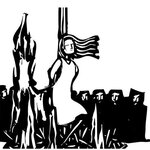Anthropology

In 1605, England’s parliament was sitting on a powder keg, literally. Like now, the country was bitterly divided between two factions, with religion at the heart of the schism after the Reformation pitted Protestants and Catholics against each other in a life or death struggle. History tells us that instead of seeking a political solution such as an election, a group of 13 Catholic conspirators plotted to blow up parliament.
The conspiracy aimed to assassinate King James I and the Protestant establishment with a massive explosion under the House of Lords. Every “fifth of November” since then…

“Witch hunt” – it’s a refrain used to deride everything from impeachment inquiries and sexual assault investigations to allegations of corruption.
When powerful men cry witch, they’re generally not talking about green-faced women wearing pointy hats. They are, presumably, referring to the Salem witch trials, when 19 people in 17th-century Massachusetts were executed on charges of witchcraft.
Using “witch hunt” to decry purportedly baseless allegations, however, reflects a misunderstanding of American history. Witch trials didn’t target the powerful. They persecuted society’s most marginal…

It was easy to make a strong adhesive in the Stone Age so claims about the presence of glue 50,000 years ago meaning higher intelligence for "Neanderthals" don't stick very well.
Neanderthals and other early humans produced a tarry glue from birch bark to make tools and because modern anthropologists think birch tar could only be created through a complex process in which the bark had to be heated in the absence of air, they used that as proof of a high level of cognitive and cultural development.
But a new study shows that there is a very simple way to make the glue.
Prior…

People eat more with friends and family than when dining alone and evolutionary psychologists have defied Occam's razor and come up with an unnecessarily complex explanation for why, speculation that it could be an ancient throwback to our early ancestors' approach to survival.
Ancient hunter gatherers shared food because it protected against periods of food insecurity and the authors suggest that this may be a biological survival mechanism that still persists today, leading to people eating more with friends and family. As support for their beliefs they note other claims that those…

The imagery of the ideal housewife was just what it reads like, a convention fabricated by male-dominated urban advertising executives to sell stuff.
Because it was an ideal, some women adopted it, and some men wanted it, and therefore it grew, but it largely faded away as culture wised up to claims about organic food and alternative medicine in the early 2000s.
Yet it has seen a resurgence, according to a new paper. And that has been due to paid influencers. You have seen those even if you don't know what they are. If you turn on "Today" and see a young thin woman you don't recognize who…

In 2006, a tiny brown pebble, equivalent to a raisin, sold at auction for $25,000. This inconsequential artifact was, in fact, William Shatner’s kidney stone. The US actor had persuaded doctors to return the grisly relic to him following surgery, so he could auction it for charity. It was bought by an online casino that added it to its collection of oddities, which include a grilled cheese sandwich graced with an image of the Virgin Mary. Stranger still, this extraordinary interest in curiosa is not an uncommon occurrence, neither today nor throughout history.
Graceland, Neverland, James Dean…

Though a modern naturalism movement has tried to shame mothers who don't, won't, or can't breastfeed, using bottles of animal milk - the prehistoric version of formula - turns out to be an ancient tradition.
Infant feeding vessels made of clay first appear in Europe in the Neolithic and became more commonplace throughout the Bronze and Iron Ages. The vessels are small enough to fit in a baby's hands, have a spout, and sometimes even feet and are shaped like imaginary animals.
Like all bottles, they could also have been used to feed sick people so whether or not they were used for…

Anthropologists have long speculated about why neanderthals while Homo sapiens thrived? Was it some sort of plague specific only to Neanderthals? A cataclysmic event in their homelands?
A new paper in Anatomical Record posits that it was not some exotic pathogen, but chronic ear infections and plain old evolution. Ear infections are common in kids but how serious they are is a matter of debate. In parts of culture worried about both modern medicine antibiotic resistance, some parents believe an ear infection should just rest while a lot of older people with poor hearing believe kids should…

Though there is far less economic inequality in America than at any point in history - poor people in America live in more square footage per person than the middle class in France, not to mention the low cost of food, TVs, and cell phones - there is a longing in some quarters to reduce it at the fringes. There are complaints, for example, that the .00001 running companies make high multiples of what the average employee gets.
Yet economic inequality has been around for as long as humans have done more than forage for food. Some even insist that economic inequality happened because of…

No matter how far back in recorded time you go, you were once an intruder. Native Americans of 1800 were genetically different from the natives who lived in North America of 1600, who had little in common with those 1400. Yet none of them were original settlers.
And when we think of Vikings, we think of ancient people hundreds of years before that, but they were once intruders too, and they caused a unique population of Icelandic walrus to disappear 1,100 years ago as they expanded.
The presence of walruses in Iceland and their disappearance as early as the Settlement period (circa 870…